Getting the Job Done—Work
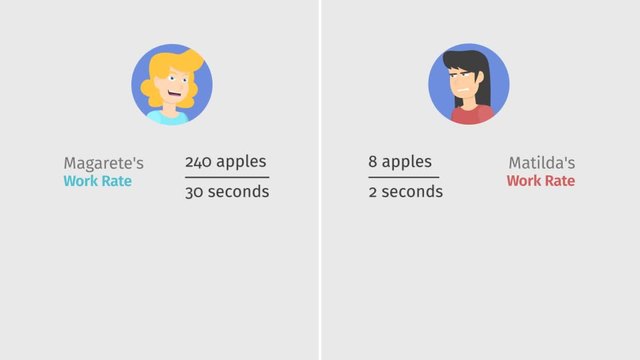

Basics on the topic Getting the Job Done—Work
After this lesson, you will be able to solve real world problems involving work rate.
The lesson begins by teaching you that the work rate is a rate at which work is done in a certain amount of time. It leads you to learn that the work rate is a ratio and can be converted to its unit work rate. It concludes with a more complex sample problem about work rate.
Learn about work rate by helping Margarete and Matilda measure their ability to complete the challenges they face during their journey to see the magical fairy Holly.
This video includes key concepts, notation, and vocabulary such as the term ratio (a relationship between two non-negative numbers, both of which are not zero); unit rate (a ratio of a quantity to one of another); and work rate (a rate at which work is done in a certain amount of time).
Before watching this video, you should already be familiar with ratios and unit rates.
After watching this video, you will be prepared to learn how to solve real world problems involving work rates.
Common Core Standard(s) in focus: 6.RP.A.3.B A video intended for math students in the 6th grade Recommended for students who are 11 - 12 years old
Transcript Getting the Job Done—Work
Once upon a time... There lived two sisters, Margarete and Matilda. Margarete is cheerful and always works quickly. Matilda, not so much. The sisters are on their way to meet the magical fairy Holly. On their way, they will encounter challenges. To see how they complete the challenges ahead, we need to understand how they get the job done using work rates. On their way, they come across two trees in trouble. Their branches are heavy with apples and the trees need a rest! They ask the sisters to shake some apples from their branches. Each sister goes to a tree and starts shaking. "Happy to help, Margarete shakes off apples from her tree at a rate of 240 apples per 30 seconds." Meanwhile, Matilda shakes off apples from her tree at a rate of only 8 apples per 2 seconds. These are Margarete and Matilda's work rates, or rates at which work is done in a certain amount of time. In order to compare Margarete and Matilda's work rates, we must rewrite them so that both work rates have the same denominator. We can do this by converting each work rate to their unit work rate, or how many apples shaken off per one second. Dividing the numerator and denominator by 30, we see that Margarete shakes off 8 apples per second. Nice work, Margarete! Dividing the numerator and denominator of Matilda's work rate by 2 gives Matilda a unit work rate of 4 apples per second. Nice effort, Matilda. Now we can compare which sister shook the most apples per second. Comparing Margarete's and Matilda's work rates, we see that Margarete shook twice as many apples per second. Margarete is definitely the better apple shaker! Is anyone surprised? The sisters continue through the woods and smell bread baking in two stone ovens. Uh oh, the bread loaves in the ovens are calling for help. The sisters rush to remove the baking bread. If they don't get taken out quickly, they'll burn! Margarete takes out 180 loaves in 15 seconds. Impressive! Matilda takes out 200 loaves in 40 seconds. Hey, that's more loaves than Margarete! Simplifying the fraction gives Margarete a unit work rate of 12 loaves per second. Simplifying Matilda's work rate, though, gives a measly 5 loaves per second. What a slowpoke. Comparing the unit work rates side by side, we see that even though Matilda removed a little more bread, it took her a lot more time. So Margarete's work rate is actually faster. Better luck next time, Matilda. The sisters trudge on and finaly come to meet the sweet, magical fairy Holly. Holly has a pile of feather pillows. She needs the sisters to shake out as many feathers from the pillows as possible, so that she can make it snow! To complete this last task, the sisters will have to work together. Margarete shakes out 1675 feathers in 25 seconds. Matilda's arms are tired from all the bread and the apples! She shakes out just 260 feathers in 20 seconds. Margarete's unit work rate is 67 feathers per second. While Matilda's is only 13 feathers per second! But this time, the sisters aren't competing, they're working together. What is the sisters' combined work rate? We can figure this out by adding the sisters' unit work rates together, as they are fractions with the same denominator. 67 feathers per second plus 13 feathers per second is 80 feathers per second in total. Sadly, the magical fairy Holly says that the sisters did not work quickly enough make it snow. That's it! Matilda has had it with all this work! Oof! This should do the trick! As the snow falls, Matilda hears trumpets and cheers. Huh? It's just Matilda's phone alarm, waking her up for school. Wait a minute school's canceled! It's a snow day! The sisters did make it snow after all!
Getting the Job Done—Work exercise
-
Determine who has the faster work rate.
HintsThe unit work rate is found by dividing the numerator and denominator by the denominator.
- The work rate is $\frac{84\text{ apples}}{4\text{ minutes}}$
- Divide both the numerator and denominator by $4$
- The unit work rate is $\frac{21\text{ apples}}{1\text{ minute}}$.
Unit work rates can be compared because they both have the same denominator.
For example: Since $21$ is greater than $18$, $\frac{21\text{ apples}}{1\text{ minute}}>\frac{18\text{ apples}}{1\text{ minute}}$
SolutionIn the following $3$ problems, the unit work rate is found by dividing the numerator by the denominator.
1. Holly loves pumpkins so she assigns the sisters to gather as many pumpkins from the pumpkin patch that they can.
Matilda gathers pumpkins at a rate of $\frac{18 \text{ pumpkins}}{9 \text{ seconds}}$ and Magarete gathers at a rate of $\frac{90 \text{ pumpkins}}{30 \text{ seconds}}$.
- Divide the numerator and denominator by $9$ to find that the unit work rate for Matilda is $\frac{2 \text{ pumpkins}}{1 \text{ second}}$.
- Divide the numerator and denominator by $30$ to find that the unit work rate for Magarete is $\frac{3 \text{ pumpkins}}{1 \text{ second}}$.
$~$
2. To continue on their way to see the fairy, the sisters need to rake a piles of leaves so that the path is clear.
Matilda rakes leaves at a rate of $\frac{144 \text{ piles of leaves}}{24 \text{ minutes}}$ and Magarete rakes leaves at a rate of $\frac{155 \text{ piles of leaves}}{31 \text{ minutes}}$.
- The unit work rate for Matilda is $\frac{6 \text{ piles of leaves}}{1 \text{ minute}}$.
- The unit work rate for Magarete is $\frac{5 \text{ piles of leaves}}{1 \text{ minute}}$.
$~$
3. They have almost reached the fairy but a big storm blew sticks off of a tree and the sisters need to pick them up.
Matilda picks up sticks at a rate of $\frac{208 \text{ sticks}}{52 \text{ seconds}}$ and Magarete rakes leaves at a rate of $\frac{288 \text{ sticks}}{48 \text{ seconds}}$.
- The unit work rate for Matilda is $\frac{4 \text{ sticks}}{1 \text{ second}}$.
- The unit work rate for Magarete is $\frac{6 \text{ sticks}}{1 \text{ second}}$.
The sisters made it to see Holly and told her about their adventure along the way.
-
Order the work rates.
HintsTo order the values, set up the work rate as a fraction, find the unit work rate, then compare the numerators.
A unit work rate relates a quantity to one unit of another quantity.
Work Rate: $\frac{15 \text{ computers}}{5\text{ hours}}$
Unit Work Rate: $\frac{3 \text{ computers}}{1\text{ hour}}$
Solution1.Margarete rolls $108$ pretzels in $12$ minutes.
- Set up the work rate as a fraction, then divide the numerator and denominator by $9$: $\frac{108\text{ pretzels}}{9\text{ minutes}}=\frac{12\text{ pretzels}}{1\text{ minute}}$
- Set up the work rate as a fraction, then divide the numerator and denominator by $5$: $\frac{50\text{ pretzels}}{5\text{ minutes}}=\frac{10\text{ pretzels}}{1\text{ minute}}$
- Set up the work rate as a fraction, then divide the numerator and denominator by $54$: $\frac{378\text{ pretzels}}{54\text{ minutes}}=\frac{7\text{ pretzels}}{1\text{ minute}}$
- Set up the work rate as a fraction, then divide the numerator and denominator by $42$: $\frac{252\text{ pretzels}}{42\text{ minutes}}=\frac{6\text{ pretzels}}{1\text{ minute}}$
- Set up the work rate as a fraction, then divide the numerator and denominator by $39$: $\frac{156\text{ pretzels}}{39\text{ minutes}}=\frac{4\text{ pretzels}}{1\text{ minute}}$
- Set up the work rate as a fraction, then divide the numerator and denominator by $19$: $\frac{57\text{ pretzels}}{19\text{ minutes}}=\frac{3\text{ pretzels}}{1\text{ minute}}$
-
Calculate the work rate for each word problem.
HintsOne way to find the unit rate, is to convert the rate into a fraction and divide the numerator and denominator by the denominator.
Another way to find the unit rate, is to divide the first quantity by the second quantity so that the second quantity represents a quantity of one.
Roy is painting a picket fence white. He can paint $26$ pickets in $2$ hours. Roy's unit rate is $13$ pickets in 1 hour.
Solution1. Arthur works at his grandmother's house every weekend. Last weekend, his grandmother had him pick weeds in her yard. On Saturday, Arthur filled $28$ buckets of weeds in $4$ hours. On Sunday, Arthur filled $36$ buckets of weeds in $3$ hours.
- To find Arthur's unit rate on Saturday, divide both numbers by $4$ to find that he can fill $7$ buckets of weeds in $1$ hour.
- To find Arthur's unit rate on Sunday, divide both numbers by $3$ to find that he can fill $12$ buckets of weeds in $1$ hour.
- To find Margarite's unit rate, divide both numbers by $5$ to find that she can build $9$ shelves in $1$ day.
- To find the unit rate at which Randolph's works, divide both numbers by $4$ to find that Randolph can write $1.75$ pages per hour.
- The find the unit rate at which Raul works, divide both numbers by $2$ to find that Raul can write $2.5$ pages per hour.
- To find the unit rate at which Raul and Randolph work together, add the pages together and find that they can write $4.25$ pages per hour. You do not add the hours, since the unit rates are represented by fractions and when you add fractions, only add the numerators.
-
Find the fastest work rate.
HintsAn easier way to view and compare work rates is to write them as fractions.
Find the unit work rate by simplifying the fraction so that there is a $1$ in the denominator.
Since the denominator of every unit work rate is $1$, you can find the faster unit work rate by comparing numerators. The larger the numerator, the faster the unit work rate.
SolutionFor the three problems, use the steps below to find the fastest work rate:
1. Write all of the work rates as fraction.
2. Find the unit work rate for each person by dividing the fraction by the denominator.
3. The fastest work rate has the largest numerator.
$~$
1. Three friends, Anna, Ron, and Melia, are helping an elderly neighbor bake Christmas cookies. Anna can bake $95$ cookies in $2\frac{1}{2}$ hours, Ron can bake $72$ cookies in $2$ hours, and Melia can bake $84$ cookies in $2\frac{1}{4}$ hours.
- Anna's work rate is, $\frac{95\text{ cookies}}{{2\frac{1}{2}}\text{ hours}}$. Divide by $2\frac{1}{2}$ to find Anna's unit work rate, $\frac{38\text{ cookies}}{1\text{ hour}}$
- Ron's work rate is, $\frac{72\text{ cookies}}{2\text{ hours}}$. Divide by $2$ to find Ron's unit work rate, $\frac{36\text{ cookies}}{1\text{ hour}}$
- Melia's work rate is, $\frac{84\text{ cookies}}{{2\frac{1}{4}}\text{ hours}}$. Divide by $2\frac{1}{4}$ to find Melia's unit work rate, $\frac{37.3\text{ cookies}}{1\text{ hour}}$.
- Since $\frac{38\text{ cookies}}{1\text{ hour}}>\frac{37.3\text{ cookies}}{1\text{ hour}}>\frac{36\text{ cookies}}{1\text{ hour}}$, Anna baked cookies at the fastest rate.
- JC's work rate is, $\frac{20\text{ apples}}{47\text{ seconds}}$. Divide by $47$ to find JC's unit work rate, $\frac{0.43\text{ apples}}{1\text{ second}}$.
- Kate's work rate is, $\frac{18\text{ apples}}{32\text{ seconds}}$. Divide by $32$ to find Kate's unit work rate, $\frac{0.56\text{ apples}}{1\text{ second}}$.
- Jade's work rate is, $\frac{24\text{ apples}}{52\text{ seconds}}$. Divide by $52$ to find Jade's unit work rate, $\frac{0.46\text{ apples}}{1\text{ second}}$.
- Mindy's work rate is, $\frac{15\text{ apples}}{19\text{ seconds}}$. Divide by $19$ to find Kate's unit work rate, $\frac{0.79\text{ apples}}{1\text{ second}}$.
- Since $\frac{0.79\text{ apples}}{1\text{ second}}>\frac{0.56\text{ apples}}{1\text{ second}}>\frac{0.46\text{ apples}}{1\text{ second}}>\frac{0.43\text{ apples}}{1\text{ second}}$, Mindy bobs for apples at the fastest rate.
- The work rate for D&B Lawn Mowing's is, $\frac{5\text{ lawns}}{{6\frac{1}{2}}\text{ hours}}$. Divide by $2\frac{1}{2}$ to find D&B's unit work rate, $\frac{0.77\text{ lawns}}{1\text{ hour}}$.
- The work rate for Richard's Landscape Service is, $\frac{7\text{ lawns}}{{8\frac{3}{4}}\text{ hours}}$. Divide by $8\frac{3}{4}$ to find Richard's unit work rate, $\frac{0.8\text{ lawns}}{1\text{ hour}}$.
- The work rate for Sunrise Landscape is, $\frac{6\text{ lawns}}{7\text{ hours}}$. Divide by $7$ to find Sunrise's unit work rate, $\frac{0.86\text{ lawns}}{1\text{ hour}}$.
- Since $\frac{0.86\text{ lawns}}{1\text{ hour}}>\frac{0.8\text{ lawns}}{1\text{ hour}}>\frac{0.77\text{ lawns}}{1\text{ hour}}$, Sunrise Landscape mows at a faster rate than the other mowing companies.
-
Find the unit rate for each given rate.
HintsA unit rate relates a quantity to one unit of another quantity.
To find the unit rate, divide both sides of the fraction by the denominator.
Rate: $\frac{84\text{ feet}}{12\text { seconds}}$
Unit Rate: $\frac{7\text{ feet}}{1\text { second}}$
SolutionA unit work rate relates a quantity to one unit of another quantity.
- The rate is $\frac{216\text{ feet}}{9\text { seconds}}$. To find the unit rate, divide the numerator and denominator by $9$: $\frac{24\text{ feet}}{1\text { second}}$.
- The rate is $\frac{60\text{ feet}}{15\text { seconds}}$. To find the unit rate, divide the numerator and denominator by $15$: $\frac{4\text{ feet}}{1\text { second}}$.
- The rate is $\frac{198\text{ feet}}{22\text { seconds}}$. To find the unit rate, divide the numerator and denominator by $22$: $\frac{9\text{ feet}}{1\text { second}}$.
- The rate is $\frac{255\text{ feet}}{17\text { seconds}}$. To find the unit rate, divide the numerator and denominator by $17$: $\frac{15\text{ feet}}{1\text { second}}$.
- The rate is $\frac{714\text{ feet}}{51\text { seconds}}$. To find the unit rate, divide the numerator and denominator by $51$: $\frac{14\text{ feet}}{1\text { second}}$.
- The rate is $\frac{216\text{ feet}}{27\text { seconds}}$. To find the unit rate, divide the numerator and denominator by $27$: $\frac{8\text{ feet}}{1\text { second}}$.
-
Identify and add work rates.
HintsWriting work rates as fractions can help to visualize the work rate.
The unit work rate is when the denominator of the fraction is $1$.
Remember to convert all units to hours. There are $60$ minutes in $1$ hour.
SolutionFirst, write all work rates as fractions and convert minutes to hours by dividing the minutes by $60$:
- Amy's work rate: $\frac{12\text{ pies}}{4\frac{1}{2}\text{ hours}}$
- Frank's work rate: $\frac{8\text{ pies}}{177\text{ minutes}}=\frac{8\text{ pies}}{2.95\text{ hours}}$
- Lisa's work rate: $\frac{15\text{ pies}}{296\text{ minutes}}=\frac{15\text{ pies}}{4.93\text{ hours}}$
- Cece's work rate: $\frac{7\text{ pies}}{3\frac{1}{5}\text{ hours}}$
- Juliet's work rate: $\frac{17\text{ pies}}{564\text{ minutes}}=\frac{17\text{ pies}}{9.4\text{ hours}}$
- Amy's unit work rate: $\frac{2.67\text{ pies}}{1\text{ hour}}$
- Frank's unit work rate: $\frac{2.71\text{ pies}}{1\text{ hour}}$
- Lisa's unit work rate: $\frac{3.04\text{ pies}}{1\text{ hour}}$
- Cece's unit work rate: $\frac{2.19\text{ pies}}{1\text{ hour}}$
- Juliet's unit work rate: $\frac{1.81\text{ pies}}{1\text{ hour}}$
- Amy's work rate is $2.67$ pies per hour.
- If Amy and Frank work together, their unit work rate is $\frac{2.67\text{ pies}}{1\text{ hour}}+\frac{2.71\text{ pies}}{1\text{ hour}}=\frac{5.38\text{ pies}}{1\text{ hour}}$.
- If Amy and Lisa work together, their unit work rate is $\frac{2.67\text{ pies}}{1\text{ hour}}+\frac{3.04\text{ pies}}{1\text{ hour}}=\frac{5.71\text{ pies}}{1\text{ hour}}$.
- If Amy and Cece work together, their unit work rate is $\frac{2.67\text{ pies}}{1\text{ hour}}+\frac{2.19\text{ pies}}{1\text{ hour}}=\frac{4.86\text{ pies}}{1\text{ hour}}$.
- If Amy and Juliet work together, their unit work rate is $\frac{2.67\text{ pies}}{1\text{ hour}}+\frac{1.81\text{ pies}}{1\text{ hour}}=\frac{4.48\text{ pies}}{1\text{ hour}}$.
- Since $\frac{5.71\text{ pies}}{1\text{ hour}}>\frac{5.38\text{ pies}}{1\text{ hour}}>\frac{4.86\text{ pies}}{1\text{ hour}}>\frac{4.48\text{ pies}}{1\text{ hour}}$, the fastest to slowest partnership with Amy is Lisa, Frank, Cece, Juliet.

From Ratios to Rates and Rates to Ratios
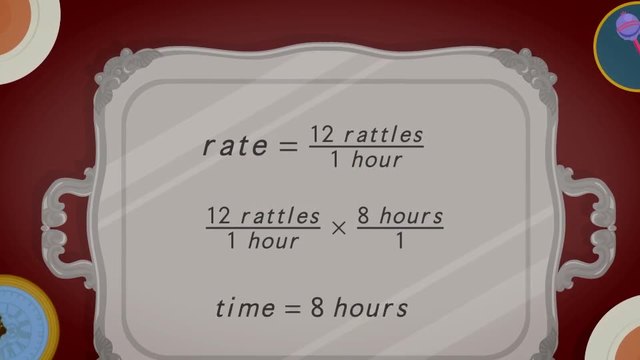
Finding Rates with Division
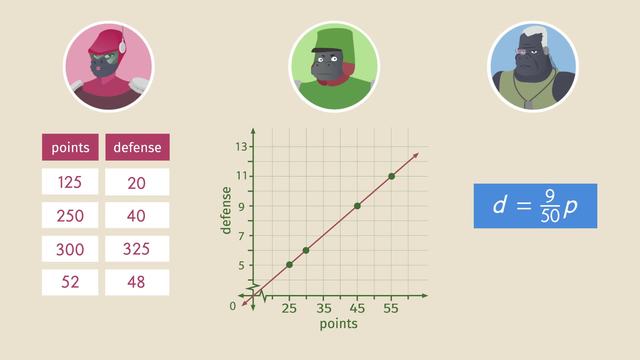
Comparison Shopping: Unit Price and Related Measurements

Getting the Job Done—Speed

Getting the Job Done—Work
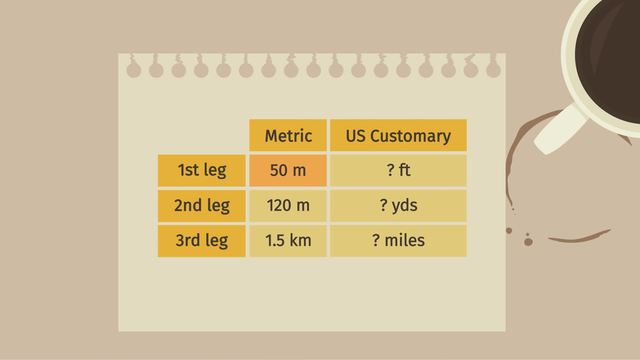
Getting the Job Done: Converting Units of Measurement
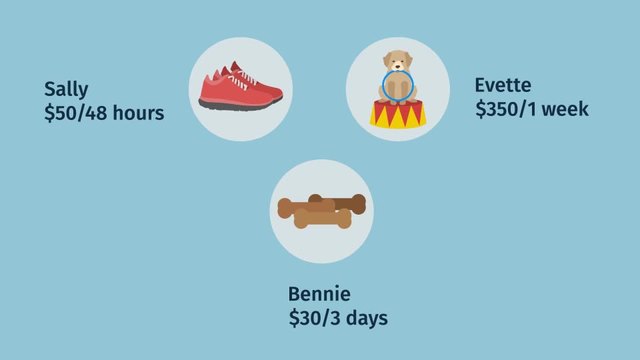
Problem Solving Using Rates, Unit Rates, and Conversions
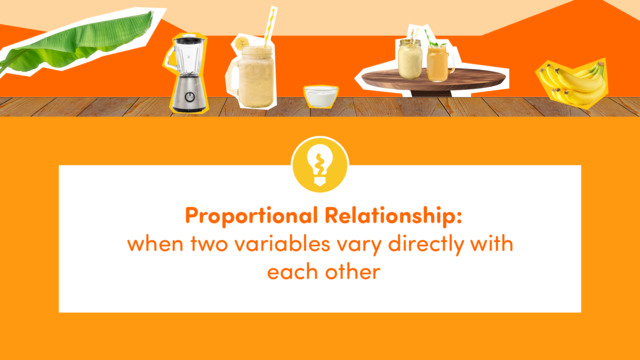
What is a Proportional Relationship?











